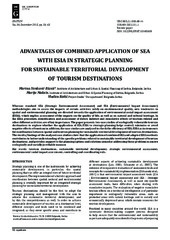Advantages of combined application of sea with ESIA in strategic planning for sustainable territorial development of tourism destinations
Апстракт
Whereas standard SEA (Strategic Environmental Assessment) and EIA (Environmental Impact Assessment) methodologies aim to assess the impacts of certain activities solely on environmental quality, new tendencies in spatial and environmental planning are directed towards the application of environmental social impact assessment (ESIA), which implies assessment of the impacts on the quality of life, as well as on natural and cultural heritage. In the ESIA procedure, identification and assessment of direct, indirect and cumulative effects of tourism-related and other different activities are of key importance. The paper presents two case studies of ecologically vulnerable tourism destinations to explore whether the application of SEA/ESIA to strategic planning helps control, minimize or avoid negative effects of tourism; in addition, the case studies are analysed to check the efficiency of SEA/ESIA as instruments for coordination between spatial and tourism planning for sustainable territor...ial development of tourism destinations. The results/findings of the analysed case studies show that the application of combined SEA and adapted ESIA methods contributes to better understanding of the specific problems related to sustainable territorial development of tourism destinations, and provides support to the planning options and solutions aimed at addressing these problems n a more ecologically and socially justifiable manner.
Кључне речи:
Controlling and coordinating role / Environmental social impact assessment / Strategic environmental assessment / Sustainable territorial development / Tourism destinationsИзвор:
Spatium, 2015, 1, 34, 56-63Издавач:
- Institute of Architecture, Urban & Spatial Planning of Serbia
Финансирање / пројекти:
- Одрживи просторни развој Подунавља у Србији (RS-MESTD-Technological Development (TD or TR)-36036)
- Улога и имплементација државног просторног плана и регионалних развојних докумената у обнови стратешког истраживања, мишљења и управљања у Србији (RS-MESTD-Integrated and Interdisciplinary Research (IIR or III)-47014)
Група
RAUmPlanTY - JOUR AU - Nenković-Riznić, Marina AU - Maksin, Marija AU - Ristić, Vladica PY - 2015 UR - https://raumplan.iaus.ac.rs/handle/123456789/259 AB - Whereas standard SEA (Strategic Environmental Assessment) and EIA (Environmental Impact Assessment) methodologies aim to assess the impacts of certain activities solely on environmental quality, new tendencies in spatial and environmental planning are directed towards the application of environmental social impact assessment (ESIA), which implies assessment of the impacts on the quality of life, as well as on natural and cultural heritage. In the ESIA procedure, identification and assessment of direct, indirect and cumulative effects of tourism-related and other different activities are of key importance. The paper presents two case studies of ecologically vulnerable tourism destinations to explore whether the application of SEA/ESIA to strategic planning helps control, minimize or avoid negative effects of tourism; in addition, the case studies are analysed to check the efficiency of SEA/ESIA as instruments for coordination between spatial and tourism planning for sustainable territorial development of tourism destinations. The results/findings of the analysed case studies show that the application of combined SEA and adapted ESIA methods contributes to better understanding of the specific problems related to sustainable territorial development of tourism destinations, and provides support to the planning options and solutions aimed at addressing these problems n a more ecologically and socially justifiable manner. PB - Institute of Architecture, Urban & Spatial Planning of Serbia T2 - Spatium T1 - Advantages of combined application of sea with ESIA in strategic planning for sustainable territorial development of tourism destinations VL - 1 IS - 34 SP - 56 EP - 63 DO - 10.2298/SPAT1534056N ER -
@article{
author = "Nenković-Riznić, Marina and Maksin, Marija and Ristić, Vladica",
year = "2015",
abstract = "Whereas standard SEA (Strategic Environmental Assessment) and EIA (Environmental Impact Assessment) methodologies aim to assess the impacts of certain activities solely on environmental quality, new tendencies in spatial and environmental planning are directed towards the application of environmental social impact assessment (ESIA), which implies assessment of the impacts on the quality of life, as well as on natural and cultural heritage. In the ESIA procedure, identification and assessment of direct, indirect and cumulative effects of tourism-related and other different activities are of key importance. The paper presents two case studies of ecologically vulnerable tourism destinations to explore whether the application of SEA/ESIA to strategic planning helps control, minimize or avoid negative effects of tourism; in addition, the case studies are analysed to check the efficiency of SEA/ESIA as instruments for coordination between spatial and tourism planning for sustainable territorial development of tourism destinations. The results/findings of the analysed case studies show that the application of combined SEA and adapted ESIA methods contributes to better understanding of the specific problems related to sustainable territorial development of tourism destinations, and provides support to the planning options and solutions aimed at addressing these problems n a more ecologically and socially justifiable manner.",
publisher = "Institute of Architecture, Urban & Spatial Planning of Serbia",
journal = "Spatium",
title = "Advantages of combined application of sea with ESIA in strategic planning for sustainable territorial development of tourism destinations",
volume = "1",
number = "34",
pages = "56-63",
doi = "10.2298/SPAT1534056N"
}
Nenković-Riznić, M., Maksin, M.,& Ristić, V.. (2015). Advantages of combined application of sea with ESIA in strategic planning for sustainable territorial development of tourism destinations. in Spatium Institute of Architecture, Urban & Spatial Planning of Serbia., 1(34), 56-63. https://doi.org/10.2298/SPAT1534056N
Nenković-Riznić M, Maksin M, Ristić V. Advantages of combined application of sea with ESIA in strategic planning for sustainable territorial development of tourism destinations. in Spatium. 2015;1(34):56-63. doi:10.2298/SPAT1534056N .
Nenković-Riznić, Marina, Maksin, Marija, Ristić, Vladica, "Advantages of combined application of sea with ESIA in strategic planning for sustainable territorial development of tourism destinations" in Spatium, 1, no. 34 (2015):56-63, https://doi.org/10.2298/SPAT1534056N . .



